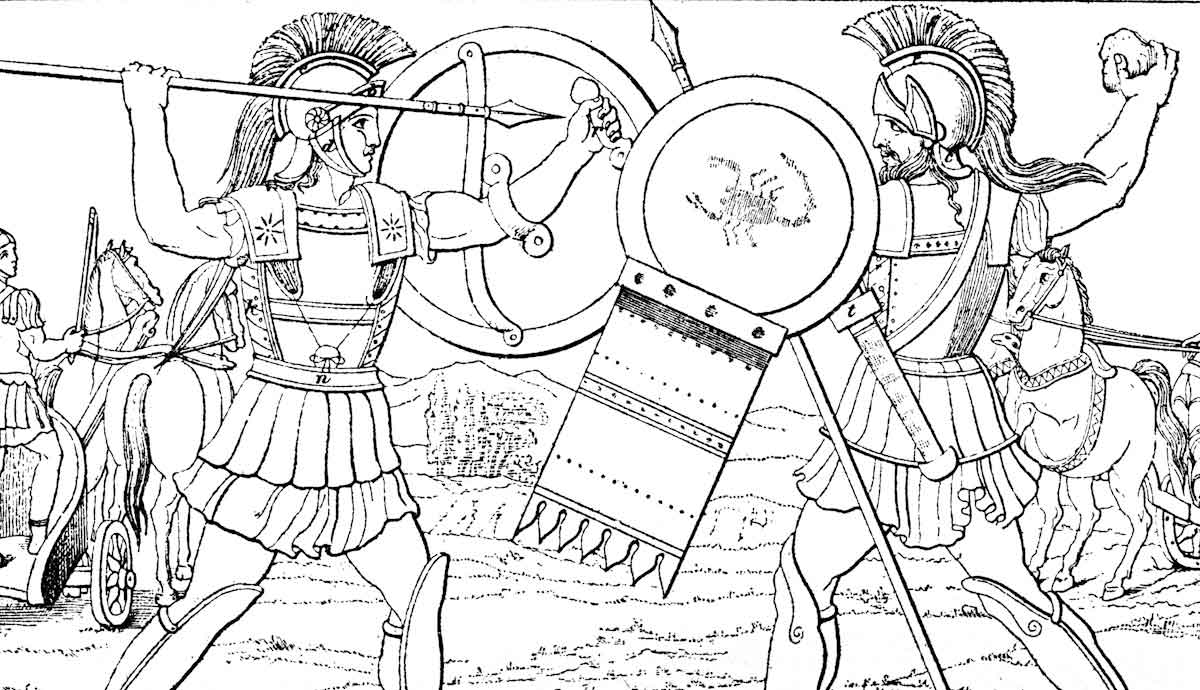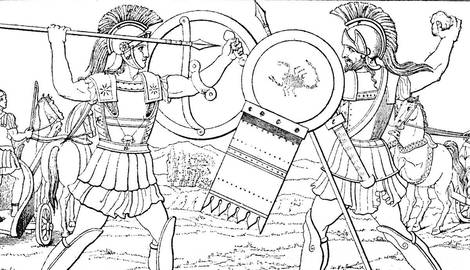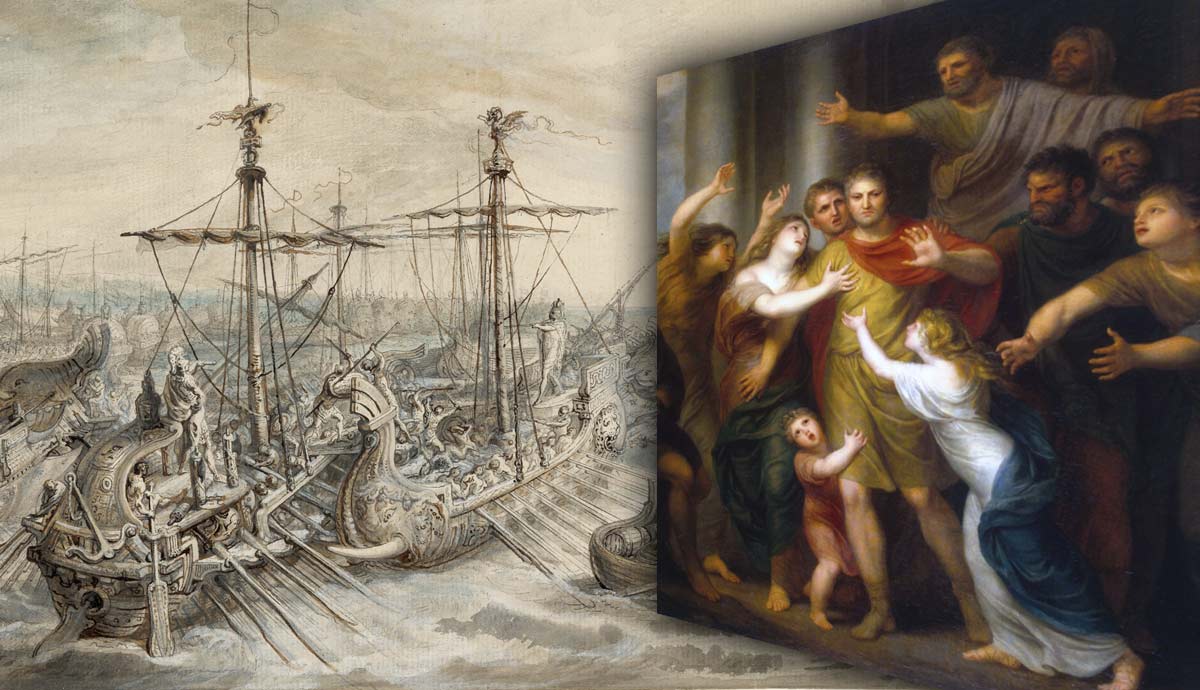
summary
- The Battle of Himera (480 BCE) pitted the Ancient Greeks of Sicily against Carthage for control of the Mediterranean trade routes around Sicily.
- Cause: The conflict began when Gelon of Syracuse and Theron of Akragas wanted to limit the power of Anaxilias of Rhegium and Terillus of Himera.
- Carthaginian Intervention: Terillus sought aid from Hamilcar of Carthage, who led a massive force of 300,000 men (according to Herodotus) to defend Himera.
- Decisive Victory: The Greeks achieved a decisive victory, driving the Carthaginians from Sicily for seven decades.
Since the fall of Phoenician Tyre, the Mediterranean, once interconnected by vast trade networks running from southern Iberia to the Levantine coast, was in flux. Sicily was perfectly positioned to serve as a central commercial hub for the two halves of the sea. But who would control it? The Carthaginians, heirs of their Phoenician ancestors, or the colonial Sicilian Greeks with their famed capital of Syracuse. For nearly a century, the two powers would muster countless men, mercenaries, and fleets to answer this question, and it all began at Himera.
Before the Battle of Himera: The Lines Are Drawn

Carthaginians, native Sicilians, and Greek colonists all vied for territory on Sicily since the 8th century BCE. The Greeks had the major city of Syracuse on the east coast, while the Carthaginians were concentrated in the west, where they established lucrative ports and colonies that they defended with decisive proactivity, thwarting several attempts by Greek colonists to settle there. By the 5th century BCE, a complex web of treaties, marriage alliances, and local despots developed, ensuring that the once small and sporadic conflicts would escalate and draw in mercenaries from nearly every corner of the Mediterranean.
In 485 BCE, the ruling aristocracy of Syracuse, known as the Gamori, were forced out of the city by the common people and turned to Gelon, the ruler of Gela, for help. Seizing on the civil unrest, the ambitious young man used his army to take control of Syracuse. Seeking legitimacy for his new regime, the tyrant married the daughter of Theron of Akragas, on the south coast of Sicily. Legitimacy was not his only goal. A rival, Anaxilas of Rhegium, located on the toe of Italy opposite Italy, had taken the town of Zancle (Messina) to gain control over the Messenian Straits, threatening the eastern half of Sicily. Anaxilas was a well-connected man. His father-in-law also happened to be a tyrant, controlling a small town on the northern coast of Sicily. It was called Himera.

Another duo of despots vying to control crucial shipping lanes could not be tolerated. It was against Anaxilas’ father-in-law that the new partnership of Gelon of Syracuse and Theron of Akragas first moved. Terillus of Himera was expelled, and he instinctively sought aid from his son-in-law. They turned to the one man in the region who could contend with the wealth and arms of a united Akragas and Syracuse: Hamilcar of Carthage.
Inherently leery of the Syracusans and any concentration of Greek power, Hamilcar agreed to aid Terillus and “brought against Gelon three hundred thousand Phoenicians, Libyans, Iberians, Ligyes, Elisyci, Sardinians, and Cyrnians” (Herodotus 7.165). In 480 BCE, the invasion of Sicily began, and the two new ententes would meet on the fields of Himera to decide the fate of Sicily.
Herodotus’ Account of the Battle

Writing only a generation after Himera, Herodotus’ account (Book 7.165-167) is the most contemporary retelling of the battle. Yet, it remains frustratingly vague despite his claim that it was based on the stories of the Carthaginians themselves.
The historian’s estimate of 300,000 Carthaginian men landing on Sicily is surely hyperbolic. The Carthaginians, undoubtedly, mobilized a massive, multi-ethnic force, yet the Syracusan force response was similar. An army comprised of men from all over the Greek world was mustered to match the Carthaginian threat.

The armies fought for hours, neither gaining the upper hand. The “barbarians,” as Herodotus calls them, held the field against the Greek coalition. Meanwhile, in his tent, the pious Hamilcar, whom Herodotus calls the king of Carthage, performed a sacrificial ritual to gain favorable omens for his endeavor. His efforts were in vain, and the sight of his army collapsing caused him to throw himself onto the huge sacrificial pyre. Far from being a shameful act, Hamilcar’s self-immolation was lauded by the Carthaginians, even inspiring honorific ruler cults to be established.
Herodotus’ account leaves out much of the actual battle, focusing instead on the figures of Gelon and Hamilcar, who are both portrayed as upright and noble men despite their contrasting fates.
Diodorus’ Account of the Battle of Himera

Most of Diodorus Siculus’ voluminous work has not survived to the present day. However, his account of Himera does remain (Book 11.21-23), giving us much of the detail that Herodotus’ account lacks. Writing in the 1st century CE, he tells us that Gelon, a tyrant of Syracuse, brought 50,000 men into the field. He rushed his men across the island to meet the invaders and quickly fortified the town of Himera.
Hamilcar had set out from Carthage with 200 warships and 3,000 transport vessels. Rather than land on Sicily’s nearby southern coast, the Carthaginians circumnavigated the island to land in the north near Himera. This saw the fleet battered by storms, and Hamilcar lost his vessels carrying his chariots and horses. Landing at Panormus, Hamilcar spent three days reorganizing his troops and repairing his fleet before marching along the coast to Himera, with his fleet sailing alongside. While Theron and his Greek forces were already present, they did not interfere with the Carthaginians setting up their camps. While 20 triremes remained to patrol the sea, the rest were sent to Sardinia and Africa for more supplies.

Not long after arrival, Hamilcar defeated Theron in a pitched battle outside Himera, but that is when Gelon arrived with his troops. Some of the Carthaginians had strayed too far from their camp and were quickly taken prisoner by the mobile Syracusan cavalry. From them, Gelon learned that the enemy force had pulled some of their boats ashore and were expecting allies from the local town of Selinus to join them shortly.
Gelon ordered his cavalry to ride up to the walls, posing as the friendly Selinuntians. Once inside the camp, they were to set fire to the ships. An alarm was raised as soon as the fire from the ships could be seen. It was at that moment that Gelon led his force in a shattering charge against the Carthaginian camp. Panicked by the flames and the oncoming army, the Carthaginian coalition scrambled to the walls. It was in this maelstrom that Hamilcar, conducting his ritual to Poseidon, was slain.
Like Herodotus, Diodorus relays that the battle was hard fought. Slowly, as the flames from their destroyed fleet grew higher and thicker, word began to trickle through the Carthaginian ranks that their commander was dead. With their fleet burning, the Carthaginian lines broke, and a great slaughter ensued. Gelon gave the order that no mercy was to be given. But there were also significant deaths of the Greek side, with the Iberians in the Carthaginian army reforming and attacking the disorganized Greeks as they looted the camps. It was only with the intervention of Theron’s troops that the Iberians were forced to retreat to their ships. They were later forced to surrender due to a lack of supplies.
So great were the casualties that Diodorus reports that not a man who landed on Sicily returned to Carthage.
Greek Triumph

When we think of decisive battles in ancient history, we think of Salamis, Gaugamela, or Caesar’s stunning victory at Alesia. We do not think of Himera. Perhaps it is because, to noble Greeks drunk from their victory over the mighty Persians, Sicily was a backwater. However, in the ancient mind, Himera stood alongside other legendary victories. Both ancient accounts agree that it was a shattering victory for the Syracusans. It would drive the Carthaginians from the island for the next seven decades.

Gelon reportedly returned to Syracuse in triumph, where he shared the spoils of the war with all who had helped him and recounted his deeds for the people of the city, who decided to reconfirm his position as tyrant. He died just two years later, with rulership passing to his brother Hieron.
Gelon commemorated the event by dedicating a monument at Delphi, making sure to broadcast his victory to the wider Greek world. From the spoils, he also struck a magnificent series of silver decadrachms he referred to as Demareteia after his wife. The style adopted for this issue would go on to influence Carthage’s own religious iconography during the subsequent rise of Tanit’s cult within the capital city. She was considered the consort of Baal Hammon and the equivalent of Athena.
A Carthaginian Conspiracy?

Herodotus (7.166) tells us that the battle took place the same day as the naval triumph at Salamis. While likely not chronologically true, the two victories, in his mind, were equally monumental, serving as an emphatic statement on the triumph of Hellenism. Similarly, Diodorus (11.24) reports that the battle actually took place on the same day as the Battle of Thermopylae. For narrative purposes, it was important for the ancient authors to emphasize the connection between the two conflicts. Diodorus did not even see them as separate. He asserted that the Persians had coordinated their invasion with the Carthaginians to destroy the Greek world once and for all (Diodorus, 11.20).
However, there is little evidence outside Greek literature to suggest a coordinated, anti-Greek alliance. The Carthaginians were as deeply suspicious of the Persians as they were of the Sicilian Greeks. Three decades prior, Persia had planned an invasion of Carthage. It was only thwarted by the Phoenicians’ unwillingness to sail against their Punic daughter colony.
In fact, it was not the Carthaginians who contacted the Persians. It was Gelon of Syracuse himself. Seeking aid for his campaign against the Carthaginians, he sent the traditional sign of friendship to King Xerxes: earth and water. He was a pragmatist with no compunctions about dealing with an enemy of other Greek city-states. There was no panhellenic loyalty, nor was there a pan-Mediterranean alliance formed against it.
The defeat at Himera has significant consequences for Carthage. The loss undermined the power of the old nobility, and they were replaced by the Carthaginian Republic. Kings were still elected, but power was increasingly moved to the Senate and the Council of 104, who were in the habit of exiling generals who did not bring success on the battlefield. There is no evidence that Carthage was involved in any Greek affairs of the next 70 years, including aiding allies such as the Elymians and the Etruscans, who were in conflict with the Greeks at the time. This suggests that Carthage was militarily crippled and needed time to rebuild its strength.
The Two Hundred Years War

Some have argued that the repercussions of the defeat in 480 BCE were disastrous for the Carthaginians, setting them back decades on the world stage (see Warmington, Carthage,1960). While this is true if our scope is limited solely to Sicily, Carthage, at large, continued to thrive through the 5th century BCE, both commercially and militarily. Their influence in Sicily lessened after the defeat at Himera, but their ambitions did not wane. They began to launch military campaigns into the interior of North Africa, kickstarting an agrarian aspect to an economy that had previously relied nearly entirely on maritime commerce (Pilkington, The Carthaginian Empire 550-202 BCE, 2019).
In 410 BCE, spats among Sicilian city-states would once again draw Carthage into the fray. This time, the expedition was led by Hannibal Mago. His grandfather was Hamilcar, the Carthaginian commander who lost his life at Himera. His grandson was seemingly less pious and wasted no time in taking his familial revenge.
The Second Battle of Himera did not go as well for the Sicilian Greeks. Hannibal won a resounding victory and sacrificed 3,000 prisoners on the same spot where his grandfather was sacrificed nearly 75 years earlier. Gelon’s Temple of Syracusan Victory, erected after the first battle, was demolished as Hannibal continued his revenge tour (Diodorus, 13.62.4). The Carthaginians had returned with a vengeance, but the fortune of war is fickle. Within three years, Hannibal was dead, ravaged by an unforeseen plague that would soon spread to the shores of North Africa. Sicily for the Carthaginians seemed to be forever cursed.
A Discovery Related to the Battle of Himera

While the ancient accounts of the battle are crucial to our understanding of the events, modern-day discoveries have also helped us to fill in the gaps. In 2008, an archaeological excavation uncovered a mass grave to the west of the ancient fortifications of the city. Over 100 bodies were discovered. Weapon fragments were also found in association with the inhumations. Most of the individuals were young adult males.
Interestingly, strontium isotope ratio analysis of the bodies confirms the ancient sources and proves that the Syracusan army was made up of men from all over the Greek world. The diversity represents not only mercenaries hired by Gelon but also allies who provided men. The lack of a Carthaginian presence again corroborates the outcome of the battle. The victorious Syracusans had ample time to bury their dead with care while the invaders scrambled to the burnt remains of their ships.

Conversely, the graves associated with the Second Sicilian War (410 BCE) show hastily buried bodies done out of necessity rather than reverence. An army that once represented a diverse array of the Greek world now showed only Syracusans. As in the ancient sources, it appears that in this fight, the Syracusans stood alone. Unflinching yet unable to stop the Carthaginians from securing a shocking victory.
Few could have known at the time that this great clash at Himera between two powerful nations would lead to a nearly unending string of conflicts known as the Sicilian Wars. Seven wars would be fought between the Carthaginians and the Sicilian Greeks before Carthage’s eventual showdown with Rome.










